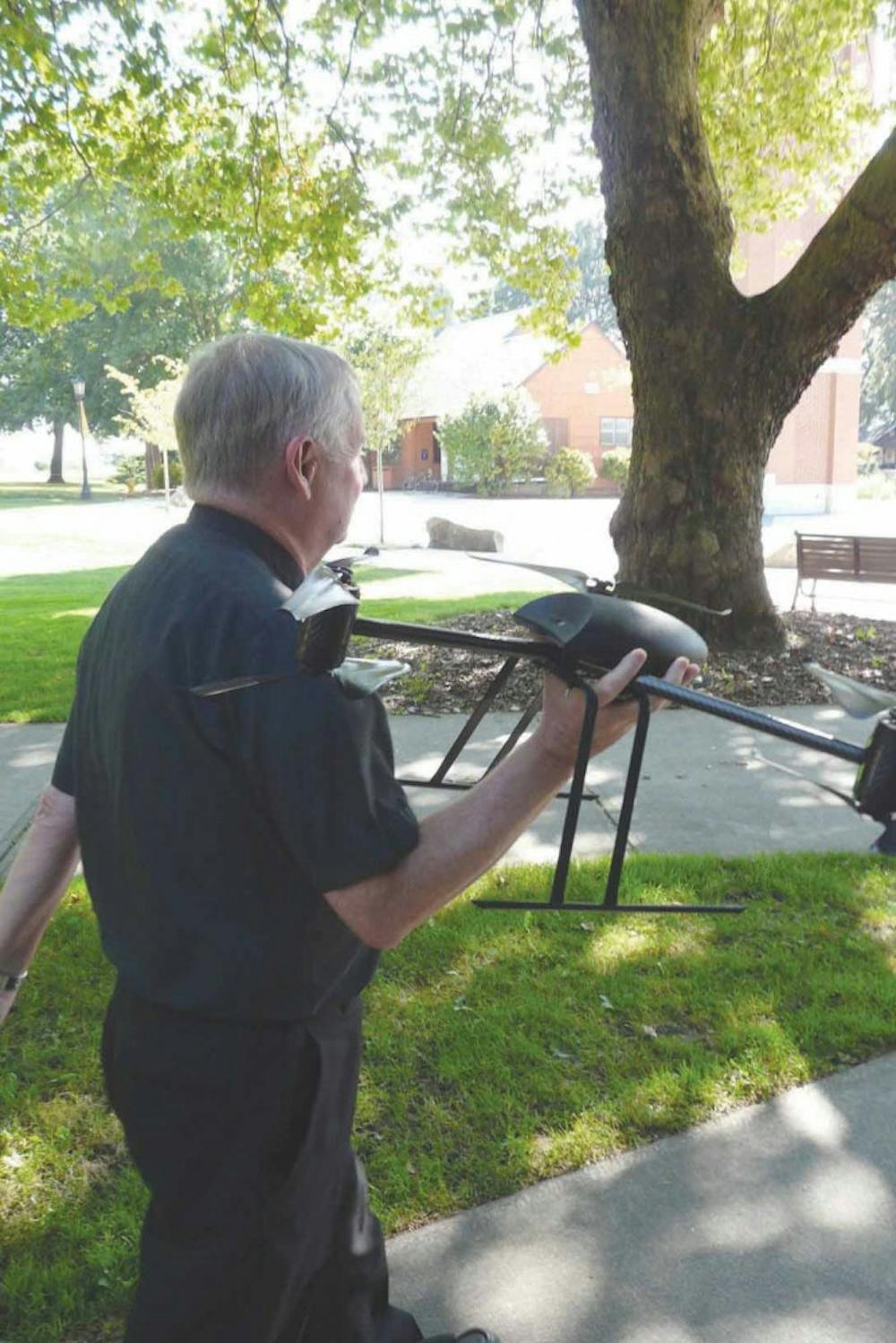Grant used to purchase helicopters and video equipment for research and sustainability use
Fr. Ron Wasowski, C.S.C., prepares to test fly the new helicopter for his Remote Sensing and Geographic Information Systems course. (Photo Courtesy of Fr. Ron Wasowski, C.S.C)
By Lisa McMahan, Copy Editor -- mcmahan11@up.edu
It's a bird!
It's a plane!
It's a thermal infrared video camera mounted on a helicopter.
Fr. Ron Wasowski, C.S.C, along with the UP science department, used a grant to purchase two helicopters and video equipment for research and sustainability use on and off of campus. In the coming months, students on campus may wonder what, exactly, those small aircrafts zooming around The Bluff are doing.
Wasowski a professor of environmental science, plans to use the custom-built helicopters and their accompanying video cameras for research in the Remote Sensing and Geographic Information Systems course.
The purchase is part of a five-year grant from the Morgan Fairchild Foundation awarded to the UP science departments, which include environmental science, biology, chemistry and physics. The 2010-2011 academic year is the fifth and final year of the grant.
The total cost of the equpiment was $52,000 and included two remote-controlled helicopters, a base station, hand controllers and three cameras: a digital still camera, a high-definition video camera, and a thermal infrared video camera, according to Wasowski.
The cameras were built by Draganfly Innovations, Inc.
Weighing one kilogram each, the carbon fiber helicopters are light, but they are far more advanced than recreational remote-controlled airplanes.
"These are not like model aircrafts, these are actually professional-grade aircrafts that the FAA (Federal Aviation Administration) would recognize," Wasowski said. "We have to jump through a lot of FAA hoops before we're able to fly one."
Wasowski is in the middle of a six-month certification process to learn how to safely operate the helicopters. Part of his training involves practicing with the aircrafts in Chiles Center, the largest open space on campus that is protected from wind and other weather elements.
Although the helicopters and their data are not being used in the classroom yet, students are excited about the possibilities they will bring for students taking the course.
"I think it will be interesting to incorporate data obtained from the helicopters into the course curriculum and group projects," senior environmental science major Nate Banet, who has already taken the course, said.
The department plans to use the cameras, which clip on to the bottom of the helicopters, for many different purposes, including monitoring streams on the west slope of Mount Hood.
"The vast majority of these stream channels are not accessible by foot," Wasowski said.
Before acquiring the helicopters, Wasowski rode along with a pilot in an actual helicopter, leaning out the door to take video from the moving aircraft.
"It didn't work," he said. "Students looking at the video for two minutes got motion sickness."
Students will use this low-altitude aerial photography collected from the thermal infrared video to monitor stream temperatures, which are crucial to the development of salmon eggs.
"You can fly a stretch of river with that thermal infrared scanner and get hundreds of times the data in a hundredth of the time," environmental science professor Robert Butler said.
Wasowski also plans to use the thermal infrared cameras this winter to evaluate the buildings on campus for heat loss.
"Once it gets cold and there's heat on campus, we plan to do a thermal inventory. You need a fairly strong temperature difference between outside air and the feature you'll be looking at," Wasowski said. "It's all part of the effort of the university to conserve as much as possible."
Once the data is collected, he plans to pass the information along to UP's administration.
The department's overall goal in introducing the helicopters is enhancing research, but also encouraging student involvement in this research.
"God willing we get it out of doors, we hope to get students familiar with drone aircrafts," Wasowski said.
Senior Andy Berrigan, a mathematics major, looks forward to seeing how the helicopters are operated.
"The helicopters will definitely relate to my career path because I would like to fly RPAs (remotely piloted aircraft), and so I will get a little glimpse of what that is like from watching Fr. Wasowski do it," Berrigan said.
One of two new helicopters purchased using grant money for research and sustainability purposes. (Photo Courtesy of Fr. Ron Waswowski, C.S.C.)
Fr. Ron must complete a six-month process to become certified to operate the aircraft. (Photo courtesy of Fr. Ron Wasowski, C.S.C.)








